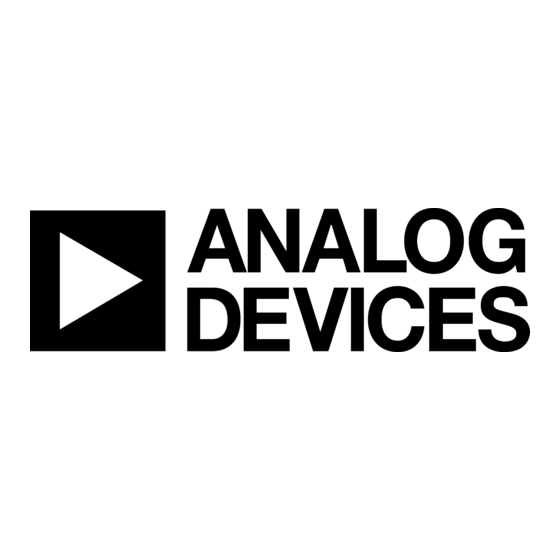
Table of Contents
Advertisement
Quick Links
One Technology Way • P.O. Box 9106 • Norwood, MA 02062-9106, U.S.A. • Tel: 781.329.4700 • Fax: 781.461.3113 • www.analog.com
Getting Started with the AD9789-EBZ Evaluation Board
WHAT'S IN THE BOX
AD9789-EBZ Evaluation Board
Evaluation Board CD
Mini-USB Cable
INTRODUCTION
The AD9789-EBZ Evaluation Board connects to a DPG2 to allow for quick evaluation of the AD9789. Control of the SPI port in the
AD9789 is available through USB with accompanying PC software. The AD9789-EBZ allows evaluation of both CMOS and LVDS modes,
as well as numerous interface modes of the AD9789. The DPGDownloader software automatically formats the data sent to the DPG2 to
account for the interface mode.
SOFTWARE
The AD9789-EBZ is designed to receive data from a DPG2. The DAC Software Suite, plus the AD9789 Update, is required for evaluation.
The DAC Software Suite is included on the Evaluation Board CD, or can be downloaded from the DPG web site at
http://www.analog.com/dpg. This will install DPGDownloader (for loading vectors into the DPG2) and the AD9789 SPI Controller
application.
HARDWARE SETUP
Connect a +5Vdc power supply to the banana jacks (P5 and P6). The clock source (AC or DC coupled) should be connected to the SMA
jack labeled S1 (HF_DACCLK), and the spectrum analyzer should be connected to the SMA jack labeled S5 (AOUT_DAC-). The DPG2
connects through connector J3 and J4, and the USB cable should be connected to XP2. Note that the PC software needs to be installed
before connecting the USB cable to your computer.
Information furnished by Analog Devices is believed to be accurate and reliable. However, no
responsibility is assumed by Analog Devices for its use, nor for any infringements of patents or other
rights of third parties that may result from its use. Specifications subject to change without notice. No
license is granted by implication or otherwise under any patent or patent rights of Analog Devices.
Trademarks and registered trademarks are the property of their respective owners.
Figure 1
RECOMMENDED EQUIPMENT
Sinusoidal Clock Source (>2GHz, <0.5ps RMS jitter) OR
Low-Frequency Clock Source (using on-board multiplier)
Spectrum Analyzer
+5Vdc Regulated Power Supply (>1.5Amp)
Data Pattern Generator Series 2 (DPG2)
Figure 2
One Technology Way, P.O. Box 9106, Norwood, MA 02062-9106, U.S.A.
Tel: 781.329.4700
Fax: 781.461.3113
©2009 Analog Devices, Inc. All rights reserved.
AD9789-EBZ
Quick Start Guide
www.analog.com
Advertisement
Table of Contents

Summary of Contents for Analog Devices AD9789-EBZ
- Page 1 INTRODUCTION The AD9789-EBZ Evaluation Board connects to a DPG2 to allow for quick evaluation of the AD9789. Control of the SPI port in the AD9789 is available through USB with accompanying PC software. The AD9789-EBZ allows evaluation of both CMOS and LVDS modes, as well as numerous interface modes of the AD9789.
- Page 2 2.0GHz tone at 2dBm. Jumpers JP9 and JP10 should be set to their CMOS position (away from the DPG2 connector). Open the AD9789 SPI application from your Start Menu (Start > Programs > Analog Devices > AD9789-EBZ > AD9789 SPI). In the lower left, click the Load button (it will stay depressed).
- Page 3 2.29376GHz tone at 2dBm. Jumpers JP9 and JP10 should be set to their LVDS position (towards the DPG2 connector). Open the AD9789 PRN software (Start > Programs > Analog Devices > AD9789-EBZ > AD9789 PRN). Click Run, and wait for the status indicator to become bright green.
- Page 4 LVDS mode, so ensure that jumpers JP9 and JP10 are in their LVDS positions (towards the DPG2 connector). Open the AD9789 SPI application from your Start Menu (Start > Programs > Analog Devices > AD9789-EBZ > AD9789 SPI). If you have the SPI controller open from a previous setup, close and re-open it before continuing.
- Page 5 Quick Start Guide AD9789-EBZ Figure 8 To begin streaming the data into the AD9789, press the Download button ( ), and then the Play button ( ). On the spectrum analyzer, the first carrier (at 834 MHz) should disappear, with a 6MHz wide channel of data in its place. This is the random data from the vector file being mapped into symbols by the QAM Mapper inside the AD9789.
- Page 6 The default values of 11 and 8 are correct for using the AD9789-EBZ with the DPG2 with a clock in the 2GHz range. After any of the options in this section are changed, the PARMNEW bit must be cycled. Enabled it (green), run the SPI controller to apply it, and then disable it (red) and run the SPI controller again.
- Page 7 Quick Start Guide AD9789-EBZ this counter is greater than zero, these Multiplier values should be adjusted. The counter should then be reset by cycling the switch to the right of the count. Rate Converter Controls The Rate Converter will affect the frequency of the Frame Sync signal. If the rate converter ratio is too large, certain modes that require many clock cycles may not be able to function.
- Page 8 ELECTRICAL INTERFACE SELECTION The AD9789-EBZ is designed to allow evaluation of both the CMOS and LVDS modes of the AD9789. For LVDS mode, the selection jumpers JP9 and JP10 should be placed closer to the DPG2 connector (labeled LVDS_BUS and LVDS_CTRL on the board). For CMOS, the jumpers should be reversed.












Need help?
Do you have a question about the AD9789-EBZ and is the answer not in the manual?
Questions and answers